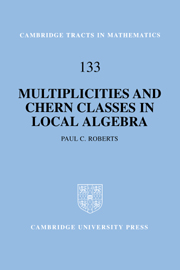Book contents
- Frontmatter
- Contents
- Preface
- Part One Multiplicities
- 1 Prime Ideals and the Chow Group
- 2 Graded Rings and Samuel Multiplicity
- 3 Complexes and Derived Functors
- 4 Homological Properties of Rings and Modules
- 5 Intersection Multiplicities
- 6 The Homological Conjectures
- 7 The Frobenius Map
- Part Two Chern Classes
- Bibliography
- Index
3 - Complexes and Derived Functors
from Part One - Multiplicities
Published online by Cambridge University Press: 29 September 2009
- Frontmatter
- Contents
- Preface
- Part One Multiplicities
- 1 Prime Ideals and the Chow Group
- 2 Graded Rings and Samuel Multiplicity
- 3 Complexes and Derived Functors
- 4 Homological Properties of Rings and Modules
- 5 Intersection Multiplicities
- 6 The Homological Conjectures
- 7 The Frobenius Map
- Part Two Chern Classes
- Bibliography
- Index
Summary
Although the use of homological methods in commutative algebra can be traced back to Hilbert, it is in more recent years that it has become a central part of the subject. One of the first uses of homological techniques was in taking free resolutions of quotients of polynomial rings by graded ideals, from which it is possible to compute the Hilbert function of the quotient. More recently, Serre introduced a homological definition of intersection multiplicities for what would now be called subschemes of a regular scheme, a development that contributed greatly to establishing the importance of homological methods. Most of these applications were originally to rings and ideals, but for various reasons it is preferable to consider the more general case of modules, and, finally, to consider the even more general case of complexes of modules, particularly complexes of the type that arise in free resolutions. In much of this book we consider complexes of modules to be the basic objects of study.
Derived Functors
In this section we give a brief account of some of the basic homological constructions that arise in the study of modules over commutative rings. As usual, we let A be a Noetherian ring, and we consider finitely generated A-modules.
- Type
- Chapter
- Information
- Multiplicities and Chern Classes in Local Algebra , pp. 42 - 63Publisher: Cambridge University PressPrint publication year: 1998



